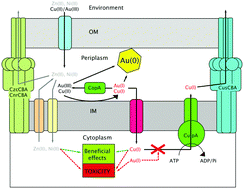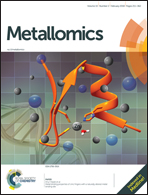Synergistic gold–copper detoxification at the core of gold biomineralisation in Cupriavidus metallidurans†
Abstract
The bacterium Cupriavidus metallidurans is capable of reducing toxic Au(I/III)-complexes into metallic gold (Au) nano-particles, thereby mediating the (trans)formation of Au nuggets in Earth surface environments. In this study we describe a novel detoxification pathway, which prevents synergistic copper (Cu)/Au-toxicity. Gold-complexes and Cu-ions exert cooperative toxicity, because cellular uptake of Au(I/III)-complexes blocks Cu(I) export from the cytoplasm by the Cu-efflux pump CupA. Using a combination of micro-analytical and biochemical methods we show that inducible resistance to these Cu/Au mixtures is mediated by the periplasmic Cu(I)-oxidase CopA, which functions as an oxygen-consuming Au(I)-oxidase. With high Au-complex loads the enzymatic activity of CopA detoxifies the reduction pathway of Au(III)-complexes via Au(I)-intermediates to Au(0) nanoparticles in the periplasm. Thereby the concentration of highly toxic Au(I) in the cytoplasm is diminished, while allowing direct reduction of Au(III) to Au nanoparticles in the periplasm. This permits C. metallidurans to thrive in Au-rich environments and biomineralise metallic Au.

- This article is part of the themed collection: Metallomics 2018 Most Downloaded Articles


 Please wait while we load your content...
Please wait while we load your content...